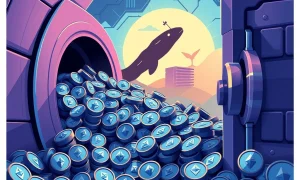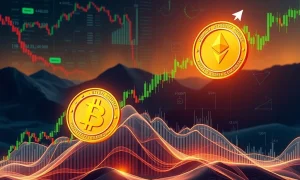The **Dot-com Bubble Parallel** is a growing concern for investors. Many market observers now highlight striking similarities between the current stock market environment and the late 1990s. This period famously culminated in the bursting of the dot-com bubble. Understanding these parallels becomes crucial for entrepreneurs and business leaders alike. They must navigate potential market shifts. This analysis explores the current record-busting stock market. It examines why some fear a repeat of history.
Today’s market shows unprecedented valuations in certain sectors. Tech stocks, in particular, have soared. This rise mirrors the internet boom era. However, underlying economic realities present a complex picture. Concerns about inflation, interest rates, and geopolitical stability persist. Investors therefore watch for signs of overheating. They remember the dramatic downturn of the early 2000s. This article will delve into specific indicators. It will also offer insights from financial experts. The goal is to provide a comprehensive overview. It helps readers understand these critical market dynamics.
Understanding the **Dot-com Bubble Parallel**
The late 1990s saw an explosion in internet-related companies. Investors poured money into these firms. Many lacked profits or clear business models. Valuations reached astronomical levels. This period is now known as the dot-com bubble. Eventually, the bubble burst in 2000. It led to significant losses for many investors. Major indices, like the Nasdaq, plummeted. Companies disappeared overnight.
Today, analysts point to several comparable trends. Firstly, we see immense speculation in specific high-growth sectors. These include artificial intelligence and electric vehicles. Secondly, many companies trade at very high price-to-earnings ratios. Some even have no earnings. Thirdly, retail investor participation is exceptionally high. They often engage in speculative trading. These factors echo the dot-com era’s excesses. They suggest a potential **Dot-com Bubble Parallel** in formation. Experts urge caution. They advise careful consideration of investment strategies.
Key Indicators of Market Exuberance
Several metrics suggest current market exuberance. These indicators resemble those seen before the dot-com crash. One significant sign is the widespread enthusiasm for IPOs. Many new companies debut with inflated valuations. Their initial public offerings often soar on day one. This indicates strong investor demand. However, their long-term viability remains uncertain. Furthermore, special purpose acquisition companies (SPACs) have become popular. These blank-check companies raise capital. They then acquire private firms. This trend also adds to market frothiness.
Another indicator is the prevalence of meme stocks. These stocks often surge due to social media hype. Their price movements disconnect from fundamental value. This phenomenon highlights speculative behavior. It involves retail investors chasing quick gains. Such activity can inflate asset prices. It creates an environment vulnerable to sharp corrections. Lastly, margin debt levels are high. Investors borrow money to buy more stocks. This amplifies both gains and losses. These combined factors paint a picture of heightened risk. They suggest the **Dot-com Bubble Parallel** is not merely theoretical.
Technological Advancements vs. Overvaluation Risks
The current technological revolution is undeniable. Artificial intelligence, blockchain, and biotechnology are transformative. These innovations drive genuine progress. They promise significant future economic growth. Companies leading these advancements often deserve high valuations. Their potential impact is immense. This fundamental difference sets the current era apart from the dot-com boom. The internet was nascent then. Its true potential was still unfolding.
Nevertheless, the pace of innovation does not justify all valuations. Some companies trade at multiples far exceeding their projected earnings. This applies even to those with strong fundamentals. Speculation can outrun reality. Investors might overlook crucial financial metrics. They instead focus on future narratives. This creates a dangerous gap. The market’s current trajectory resembles the **Dot-com Bubble Parallel** in this regard. It involves a mix of legitimate growth and speculative excess. Distinguishing between the two becomes vital for prudent investing. This challenge demands careful analysis from market participants.
Lessons from History: Navigating Market Cycles
History offers valuable lessons for today’s investors. The dot-com crash taught painful truths. It showed that even revolutionary technologies can experience speculative bubbles. Investor euphoria often blinds rational judgment. Diversification proved critical. Holding a concentrated portfolio of highly speculative stocks led to ruin for many. Furthermore, a focus on fundamentals became paramount. Companies with strong earnings and sustainable business models fared better long-term. Those without these qualities vanished.
Today’s market participants must remember these lessons. Avoid chasing every hot stock. Conduct thorough due diligence. Focus on companies with clear paths to profitability. Understand their competitive landscape. Maintain a diversified portfolio. This approach helps mitigate risks. It prepares investors for potential market downturns. The **Dot-com Bubble Parallel** serves as a potent reminder. Market cycles are inevitable. Prudent financial planning ensures resilience. It helps investors weather economic storms.
Expert Perspectives on the Current Market Climate
Financial analysts hold diverse views on the current market. Some argue against a direct **Dot-com Bubble Parallel**. They cite stronger corporate balance sheets today. They also note lower interest rates compared to the late 90s. This environment supports higher valuations. Other experts express significant concern. They highlight record high market capitalization to GDP ratios. This metric suggests overvaluation. They also point to the rapid rise of passive investing. This could exacerbate downturns. These differing opinions reflect market complexity.
Leading economists and strategists offer cautious advice. They recommend maintaining liquidity. Investors should avoid excessive leverage. They also suggest rebalancing portfolios regularly. This means selling overvalued assets. It involves buying undervalued ones. Furthermore, they emphasize long-term investing principles. Short-term market fluctuations can be dramatic. However, a focus on durable companies yields better results. The consensus points towards increased vigilance. Investors must stay informed. They should adapt their strategies as conditions evolve. This proactive stance is essential.
Mitigating Risk in a Volatile Market
Investors can adopt several strategies to mitigate risk. These steps help protect capital. They also position investors for future growth. The potential **Dot-com Bubble Parallel** necessitates such prudence.
Consider these actions:
- **Diversify investments** across different asset classes. Include bonds, real estate, and commodities. Do not solely rely on stocks.
- **Spread investments** across various sectors. Avoid overconcentration in tech or high-growth areas.
- **Practice dollar-cost averaging**. Invest a fixed amount regularly. This strategy reduces the impact of market volatility. It averages out the purchase price over time.
- **Maintain a cash reserve**. This provides a safety net during downturns. It also allows for opportunistic buying.
- **Review your portfolio regularly**. Adjust it to align with your risk tolerance. Consider your long-term financial goals.
- **Seek professional financial advice**. They offer tailored guidance. Do not let market hype dictate decisions.
The **Dot-com Bubble Parallel** serves as a stark reminder. Market history often rhymes, even if it does not repeat exactly. While the current market benefits from robust technological innovation, it also exhibits speculative tendencies. These tendencies echo the late 1990s. Investors must therefore exercise caution. They should prioritize sound financial principles. Understanding historical precedents empowers better decision-making. It fosters resilience in uncertain times. Staying informed and adaptable remains paramount for navigating today’s complex financial landscape. Prepare for various market scenarios. This proactive approach helps secure financial well-being.
Frequently Asked Questions (FAQs)
Q1: What is the Dot-com Bubble Parallel?
A: The **Dot-com Bubble Parallel** refers to similarities between the current stock market and the internet bubble of the late 1990s. These include high valuations, speculative trading, and rapid tech sector growth. Investors observe these trends for potential market overheating.
Q2: How did the original dot-com bubble burst?
A: The original dot-com bubble burst in 2000. Many internet companies, often unprofitable, saw their stock prices collapse. This followed a period of intense speculation. Investors realized that valuations were unsustainable. This led to a significant market correction.
Q3: Are current tech stock valuations sustainable?
A: Expert opinions vary on current tech stock valuations. Some argue that genuine innovation supports high prices. Others believe that speculative excess drives certain valuations beyond fundamentals. Careful analysis of individual company earnings and growth prospects is crucial.
Q4: What investment strategies help during market volatility?
A: During market volatility, investors should prioritize diversification. Spread investments across various asset classes and sectors. Practice dollar-cost averaging. Maintain a cash reserve. Rebalance portfolios regularly. Seeking professional financial advice also helps manage risk effectively.
Q5: Is a stock market crash inevitable due to the Dot-com Bubble Parallel?
A: A direct repeat of the dot-com crash is not inevitable. However, the **Dot-com Bubble Parallel** suggests increased risk. Market corrections are a normal part of economic cycles. Prudent investors prepare for potential downturns. They focus on long-term growth and risk management.
























